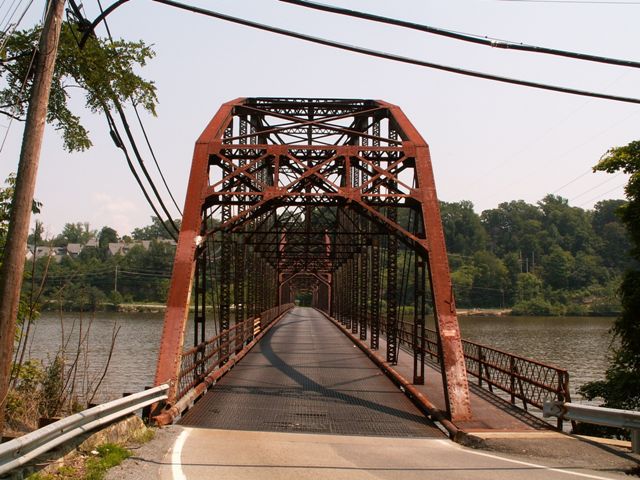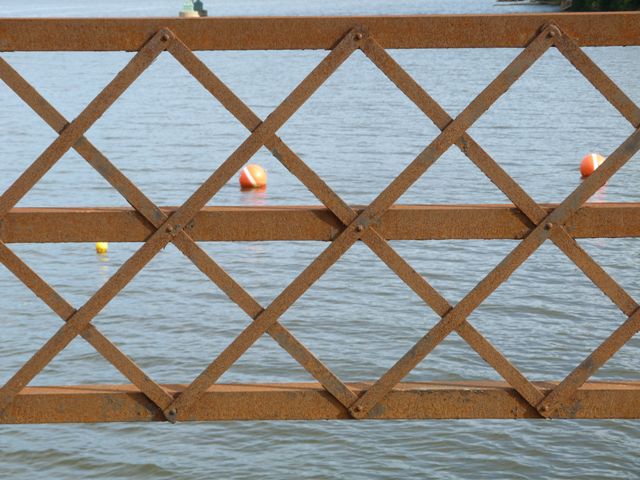We Recommend:
Bach Steel - Experts at historic truss bridge restoration.
BridgeHunter.com Phase 1 is released to the public! - Visit Now
Ices Ferry Bridge

Primary Photographer(s): Nathan Holth and Rick McOmber
Bridge Documented: August 2, 2007 and July 15, 2011
Not Available or Not Applicable
259.0 Feet (78.9 Meters)
828.0 Feet (252.4 Meters)
18 Feet (5.49 Meters)
2 Main Span(s) and 2 Approach Span(s)
31A150

View Information About HSR Ratings
Bridge Documentation
This bridge no longer exists!
View Archived National Bridge Inventory Report - Has Additional Details and Evaluation
This historic bridge was demolished by West Virginia Department of Highways, September 20, 2012!
View Historical Plan Sheets For This Historic Bridge
This bridge is a four span structure. The two largest spans are located on the western end of the bridge, and those featured pinned connections. The other two spans are smaller, feature riveted connections, and are located on the east end of the bridge. The 1922 date seems late for a bridge with pin-connected spans and featuring members that are not overly massive, and a deck that is under 20 feet wide. Regardless of whether the bridge is 1922 or is older, the fact remains that it is a very large, multi-span example of a truss bridge featuring spans that include pinned connections, and those spans are of significant length. The bridge features relatively good historic integrity, especially for West Virginia, where many surviving truss bridges display numerous alterations. The bridge even retains original railings. As a result, this is a bridge that is historically significant. In addition, it is located in a scenic lake (which is a reservoir on Cheat River) that appears to be favored for recreational use.
Despite the beauty and history of the bridge, this historic structure is being replaced and demolished. Given the length and significance of the bridge, the demolition of this bridge will be a serious loss to West Virginia's transportation heritage. It is unclear why none of the wide variety of possible alternatives to demolition were not determined to be possible at this location. Most likely it is simply because someone is not interested in taking the time to work out a preservation plan. This nation is severely lacking in its efforts and resolve to preserve historic bridges of any type save the over-rated covered bridges. Even worse is the fate of large historic bridges. Granted, preservation of larger bridges may cost more, but one must take into account the greater historic significance of larger bridges, and also the fact that large bridges tend to attract more attention and offer a larger impact on the appearance of a landscape. As such, it seems worthwhile to go the extra mile to preserve these larger bridges. Apparently, West Virginia officials do not agree with this assessment.
The bridge is in a position where alignment involves a nearly 90 degree turn to get on the bridge. As such, there does not appear to be any sacrifice to alignment quality if a new bridge is built on a new alignment next to the historic bridge, allowing the historic bridge to remain standing for its historic value. The bridge could be restored for pedestrian use. The recreational value of the area suggests that the restored bridge would be a useful and attractive part of the area.
The two larger spans are most significant because they are larger, and also because they are pin-connected. At rock bottom, the least that should be done is to relocate and preserve these two spans elsewhere.
![]()
Photo Galleries and Videos: Ices Ferry Bridge
Structure Overview
Original / Full Size PhotosA collection of overview photos that show the bridge as a whole and general areas of the bridge. This gallery offers photos in the highest available resolution and file size in a touch-friendly popup viewer.
Alternatively, Browse Without Using Viewer
![]()
Structure Details
Original / Full Size PhotosA collection of detail photos that document the parts, construction, and condition of the bridge. This gallery offers photos in the highest available resolution and file size in a touch-friendly popup viewer.
Alternatively, Browse Without Using Viewer
![]()
Structure Overview
Mobile Optimized PhotosA collection of overview photos that show the bridge as a whole and general areas of the bridge. This gallery features data-friendly, fast-loading photos in a touch-friendly popup viewer.
Alternatively, Browse Without Using Viewer
![]()
Structure Details
Mobile Optimized PhotosA collection of detail photos that document the parts, construction, and condition of the bridge. This gallery features data-friendly, fast-loading photos in a touch-friendly popup viewer.
Alternatively, Browse Without Using Viewer
![]()
Maps and Links: Ices Ferry Bridge
This historic bridge has been demolished. This map is shown for reference purposes only.
Coordinates (Latitude, Longitude):
Search For Additional Bridge Listings:
Bridgehunter.com: View listed bridges within 0.5 miles (0.8 kilometers) of this bridge.
Bridgehunter.com: View listed bridges within 10 miles (16 kilometers) of this bridge.
Additional Maps:
Google Streetview (If Available)
GeoHack (Additional Links and Coordinates)
Apple Maps (Via DuckDuckGo Search)
Apple Maps (Apple devices only)
Android: Open Location In Your Map or GPS App
Flickr Gallery (Find Nearby Photos)
Wikimedia Commons (Find Nearby Photos)
Directions Via Sygic For Android
Directions Via Sygic For iOS and Android Dolphin Browser
USGS National Map (United States Only)
Historical USGS Topo Maps (United States Only)
Historic Aerials (United States Only)
CalTopo Maps (United States Only)




